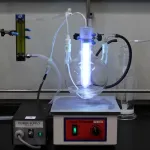(Press-News.org) By exploiting the technology used in Covid-19 vaccines, a team led by UCL, King’s College London and Moderna scientists has created an effective therapy for a rare disease, in a study in mice, demonstrating the technology’s potential therapeutic use in people.
The research, published in Science Translational Medicine, found that messenger RNA (mRNA) could be used to correct a rare liver genetic disease known as argininosuccinic aciduria in a mouse model of the disease.
Argininosuccinic aciduria is an inherited metabolic disorder that affects how the body breaks down protein – potentially leading to high levels of ammonia in the blood. Patients affected by the disease are found to also experience an imbalance of glutathione regulation, which is important for liver detoxification. The condition occurs in approximately one in 100,000 newborns.
Over the coming years, the team aims to trial the therapy in people. Messenger RNA therapies are also currently being investigated in other rare inherited metabolic diseases – propionic and methylmalonic acidaemias – in global clinical trials sponsored by Moderna, including at Great Ormond Street Hospital for Children.
Co-lead Principal Investigator, Dr Julien Baruteau (UCL Great Ormond Street Institute of Child Health), said: “Messenger RNA has revolutionised the field of vaccines during the COVID-19 pandemic. We believe it can now do the same for rare diseases.”
Rare diseases usually result from errors in the patient’s DNA and affect around 300 million people worldwide.
However, fewer than 5% of these conditions have approved therapies. Most of these treatments use gene therapy to switch out the faulty gene and replace it with a normal functioning one, to alleviate the disease.
Until recently, gene therapy employed modified viruses to bring the therapeutic gene to the disease cells. However, these viral systems can cause severe adverse effects, such as reactions from the patient’s own immune system, meaning that they can’t be rolled out widely.
Consequently, the team wanted to investigate the possibility of using mRNA technology as an alternative solution.
Messenger RNA is a molecule that contains instructions that direct the cells to make proteins. By protecting the mRNA in a microdroplet of lipids, scientists were able to inject the mice intravenously with the therapy and target their liver cells.
The researchers tested the therapy on 31 mice both from birth and at a late stage of the disease as a rescue therapy in older mice that had argininosuccinic aciduria. They also used an equal number of untreated mice as a control (comparison) group.
For the mice, the benefit of each mRNA treatment only lasted around seven days, so the procedure was performed weekly over the course of up to eight weeks. However, the researchers expect that translation to humans will allow for longer gaps between treatments.
Over the course of the trial, the mice were given positron emission tomography (PET) scans as a non-invasive way to track the correction of glutathione regulation and the success of the treatment.
Researchers found that the treatment corrected the lethal consequences of the disease. All mice with the disease at birth left untreated died within the first two weeks of life, while the mice that received the mRNA treatment at birth survived for over three months. Additionally, six out of seven mice who received mRNA treatment as rescue therapy survived, while all those that were left untreated died.
The researchers also noted that, mRNA-treated organs were very similar to those in the unaffected, control mice.
Dr Baruteau said: “We have shown that mRNA holds an unprecedented therapeutic potential for incurable genetic diseases, in particular liver conditions. We aim to apply this approach to other inherited liver diseases and translate mRNA therapy to patients, especially in children.”
Dr Tim Witney, Co-lead PI (School of Biomedical Engineering & Imaging Sciences, King’s College London), said: “This is a great example of collaborative science across multiple areas of expertise, which has yielded remarkable results. By understanding what goes wrong in this disease, we can not only correct the error, but follow this correction in real-time using imaging. We are looking forward to bringing these advances to patients in the near future.”
Dr Paolo Martini, Chief Scientific Officer for International Therapeutics Research Centres at Moderna, said: “This collaboration has exemplified how academia and industry can work in synergy to explore how mRNA technology can be harnessed against rare diseases and may potentially lead to a treatment for a severe and debilitating disease such as argininosuccinic aciduria.”
The research was funded by Moderna, the Medical Research Council, the consortium London Advanced Therapies, Wellcome, Cancer Research UK, and the National Institute for Health and Care Research (NIHR) Great Ormond Street Hospital Biomedical Research Centre.
END
mRNA technology could be possible treatment for rare diseases
Peer reviewed | Experimental study | Animals
2024-01-10
ELSE PRESS RELEASES FROM THIS DATE:
Feeling depressed linked to short-term increase in bodyweight, study finds
2024-01-10
Increases in symptoms of depression are associated with a subsequent increase in bodyweight when measured one month later, new research from the University of Cambridge has found.
The study, published today in PLOS ONE, found that the increase was only seen among people with overweight or obesity, but found no link between generally having greater symptoms of depression and higher bodyweight.
Research has suggested a connection between weight and mental health – with each potentially influencing the other – but the relationship is complex and remains poorly understood, ...
NIH-supported researchers create single-cell atlas of the placenta during term labor
2024-01-10
WHAT:
An atlas revealing the activity of individual placental cells during childbirth offers insight on what happens at the maternal-fetal interface during term labor, according to a study supported by the National Institutes of Health (NIH). The atlas provides a single-cell analysis of the human placenta and its surrounding membranes and is the first to use this method to understand the communication that occurs between maternal and fetal cells during the process of labor. Studying these processes aids understanding of typical labor and delivery at term, as well as preterm labor and delivery, which occurs before ...
Neuropsychological effects of rapid-acting antidepressants may explain their clinical benefits, new research finds
2024-01-10
Rapid-acting antidepressants, including ketamine, scopolamine and psilocybin, have been found to have immediate and lasting positive effects on mood in patients with major depressive disorder but how these effects arise is unknown. New research led by the University of Bristol explored their neuropsychological effects and found that all three of these drugs can modulate affective biases associated with learning and memory.
The paper, published in Science Translational Medicine today [10 January] was carried out in collaboration with researchers at Compass Pathways, Boehringer Ingelheim, and the University of Cambridge.
Negative affective ...
Record heat in 2023 worsened global droughts, floods and wildfires
2024-01-10
Record heat across the world profoundly impacted the global water cycle in 2023, contributing to severe storms, floods, megadroughts and bushfires, new research from The Australian National University (ANU) shows.
The findings are outlined in a new report released today by the Global Water Monitor Consortium and led by ANU researchers.
Lead author Professor Albert Van Dijk, from ANU, said the report underscores the consequences of persistent fossil fuel burning on natural disasters, water resources, biodiversity and food security.
“Record-breaking heat waves swept across the globe in 2023, shattering previous records, from Canada to Brazil and from Spain to Thailand,” ...
MD Anderson research highlights for January 10, 2024
2024-01-10
HOUSTON ― The University of Texas MD Anderson Cancer Center’s Research Highlights showcases the latest breakthroughs in cancer care, research and prevention. These advances are made possible through seamless collaboration between MD Anderson’s world-leading clinicians and scientists, bringing discoveries from the lab to the clinic and back.
Recent developments at MD Anderson include insights into the effects of the gut microbiome on remote tumors, a screening strategy for ovarian cancer early detection, a combination approach ...
Newly identified genes for depression may lead to new treatments
2024-01-10
More than 200 genes linked to depression have been newly identified in a worldwide study led by UCL researchers.
The research, published in Nature Genetics, found more than 50 new genetic loci (a locus is a specific position on a chromosome) and 205 novel genes that are associated with depression, in the first large-scale global study of the genetics of major depression in participants of diverse ancestry groups.
The study also showcases potential for drug repurposing, as one of the identified genes encodes a protein targeted by a common diabetes drug, while also pointing to new targets for drugs that ...
In hot water: coral resilience in the face of climate change
2024-01-10
From intensifying wildfires to record-breaking floods year on year, the effects of climate change have manifested in devastating outcomes on ecosystems that threaten species all over the world. One such ecosystem in peril is coral reefs, which play a major role in sustaining biodiversity in the planet’s oceans but are facing increasingly severe conditions as waters heat up leading to a phenomenon known as marine heat waves.
For nearly a decade, Katie Barott, assistant professor of biology at the University ...
JMIR Aging accepted for inclusion in MEDLINE
2024-01-10
JMIR Publications is pleased to announce that JMIR Aging has been accepted for inclusion in MEDLINE, which is the U.S. National Library of Medicine's premier bibliographic database.
JMIR Aging had already been indexed in PubMed previously. MEDLINE is a more selective subset of PubMed, consisting of the top 5,200 biomedical journals. Indexing in MEDLINE also means that articles are now also indexed with NLM Medical Subject Headings (MeSH terms) and other metadata.
Selection for MEDLINE is a result of a thorough review of the journal by reviewers from the Literature ...
Dry-cleaning fluid becomes a synthetic chemist's treasure
2024-01-10
The widely used dry-cleaning and degreasing solvent perc can be converted to useful chemicals by a new clean, safe and inexpensive procedure. The Kobe University discovery using on-demand UV activation may open the path to upcycling perc and thus contribute to a more sustainable society.
Organic synthesis is the production of useful chemicals, such as drugs, from other available chemicals. In general, chemists use source materials to create simple building blocks, such as carbonate esters, and combine them to increasingly complex structures. The source materials for this need to be reactive, but that also usually makes them toxic, such as the commonly ...
Countries and companies need to address declining global fertility rates, doctors say
2024-01-10
The global fertility rate is declining and most governments are failing to recognize and address the impact on economies and societies, say a group of physicians invited by the International Federation of Fertility Societies (IFFS) in a new paper and campaign launched today.
“Not including the effects of migration, many countries are predicted to have a population decline of more than 50% from 2017 to 2100,” the physicians write in “Declining global fertility rates and the implications for family planning and family building,” published January 10, 2024 in Human Reproduction Update.
“By 2050, 77% of predominantly high-income countries, and ...
LAST 30 PRESS RELEASES:
Making lighter work of calculating fluid and heat flow
Normalizing blood sugar can halve heart attack risk
Lowering blood sugar cuts heart attack risk in people with prediabetes
Study links genetic variants to risk of blinding eye disease in premature infants
Non-opioid ‘pain sponge’ therapy halts cartilage degeneration and relieves chronic pain
AI can pick up cultural values by mimicking how kids learn
China’s ecological redlines offer fast track to 30 x 30 global conservation goal
Invisible indoor threats: emerging household contaminants and their growing risks to human health
Adding antibody treatment to chemo boosts outcomes for children with rare cancer
Germline pathogenic variants among women without a history of breast cancer
Tanning beds triple melanoma risk, potentially causing broad DNA damage
Unique bond identified as key to viral infection speed
Indoor tanning makes youthful skin much older on a genetic level
Mouse model sheds new light on the causes and potential solutions to human GI problems linked to muscular dystrophy
The Journal of Nuclear Medicine ahead-of-print tip sheet: December 12, 2025
Smarter tools for peering into the microscopic world
Applications open for funding to conduct research in the Kinsey Institute archives
Global measure underestimates the severity of food insecurity
Child survivors of critical illness are missing out on timely follow up care
Risk-based vs annual breast cancer screening / the WISDOM randomized clinical trial
University of Toronto launches Electric Vehicle Innovation Ontario to accelerate advanced EV technologies and build Canada’s innovation advantage
Early relapse predicts poor outcomes in aggressive blood cancer
American College of Lifestyle Medicine applauds two CMS models aligned with lifestyle medicine practice and reimbursement
Clinical trial finds cannabis use not a barrier to quitting nicotine vaping
Supplemental nutrition assistance program policies and food insecurity
Switching immune cells to “night mode” could limit damage after a heart attack, study suggests
URI-based Global RIghts Project report spotlights continued troubling trends in worldwide inhumane treatment
Neutrophils are less aggressive at night, explaining why nighttime heart attacks cause less damage than daytime events
Menopausal hormone therapy may not pose breast cancer risk for women with BRCA mutations
Mobile health tool may improve quality of life for adolescent and young adult breast cancer survivors
[Press-News.org] mRNA technology could be possible treatment for rare diseasesPeer reviewed | Experimental study | Animals


